英文导游词大观园DaguanPark
- 格式:pdf
- 大小:220.96 KB
- 文档页数:2
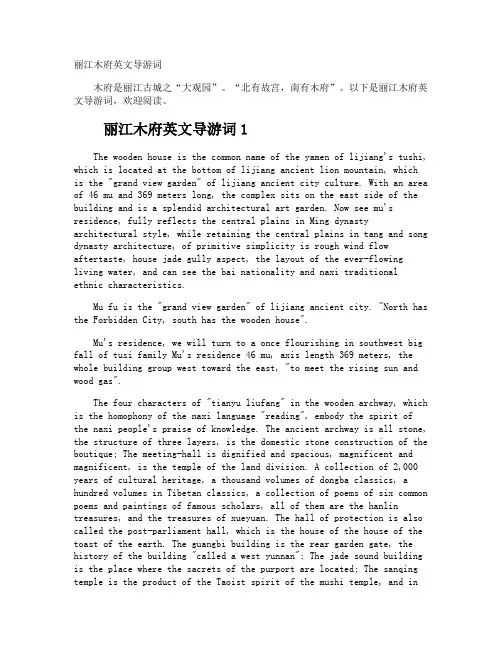
丽江木府英文导游词木府是丽江古城之“大观园”。
“北有故宫,南有木府”。
以下是丽江木府英文导游词,欢迎阅读。
丽江木府英文导游词1The wooden house is the common name of the yamen of lijiang's tushi, which is located at the bottom of lijiang ancient lion mountain, whichis the "grand view garden" of lijiang ancient city culture. With an area of 46 mu and 369 meters long, the complex sits on the east side of the building and is a splendid architectural art garden. Now see mu's residence, fully reflects the central plains in Ming dynasty architectural style, while retaining the central plains in tang and song dynasty architecture, of primitive simplicity is rough wind flow aftertaste, house jade gully aspect, the layout of the ever-flowing living water, and can see the bai nationality and naxi traditional ethnic characteristics.Mu fu is the "grand view garden" of lijiang ancient city. "North has the Forbidden City, south has the wooden house".Mu's residence, we will turn to a once flourishing in southwest big fall of tusi family Mu's residence 46 mu, axis length 369 meters, the whole building group west toward the east, "to meet the rising sun and wood gas".The four characters of "tianyu liufang" in the wooden archway, which is the homophony of the naxi language "reading", embody the spirit of the naxi people's praise of knowledge. The ancient archway is all stone, the structure of three layers, is the domestic stone construction of the boutique; The meeting-hall is dignified and spacious, magnificent and magnificent, is the temple of the land division. A collection of 2,000 years of cultural heritage, a thousand volumes of dongba classics, a hundred volumes in Tibetan classics, a collection of poems of six common poems and paintings of famous scholars, all of them are the hanlin treasures, and the treasures of xueyuan. The hall of protection is also called the post-parliament hall, which is the house of the house of the toast of the earth. The guangbi building is the rear garden gate, the history of the building "called a west yunnan"; The jade sound building is the place where the sacrets of the purport are located; The sanqing temple is the product of the Taoist spirit of the mushi temple, and inthe deep part of the lion mountain, there are also places of worship, worship ancestors, and the local religious activities of the god "department". The wooden government fully embodies the open spirit of the multi-culture of the naxi people. In the construction of the palace of his own palace, the company of zhongyi stone memorial stone memorial hall was oriented towards the sun and the east instead of the zhongyuan feng shui theory, which was a good place to sit north and south. The eastern genus of wood, the sun and the wood are the fetishism in the teaching of naxi, and also the surname of the naxi. Therefore, the idea of "wood" to make the building of the wooden house take the direction of the west facing east. The family of wooden toast, although it has the king's air quality, but an anti-zhongyuan wang city "in the middle of the worship" tradition, built the palace in the southwest corner of the city. As the center of the city is the square street of the shang jia cluster, the crisscrossing streets radiate from the commercial center of the square street. It can be seen that the ancient city was originally formed in a village fair and eventually prospered by commercial trade. This is closely related to the ancient city's history as the "tea horse ancient road".Walking into the wooden house, the oncoming is the meeting-house. The meeting-hall is dignified and spacious, magnificent and magnificent, is the temple of the land division. A collection of 2,000 years of cultural heritage, a thousand volumes of dongba classics, a hundred volumes of Tibetan classics, six books of poetry and calligraphy, and calligraphy and painting by many scholars, all of them are the hanlin treasures, and the treasures of the school. The hall of protection is also called the post-parliament hall, which is the house of the house of the toast of the earth. The guangbi building is the rear garden gate, the history of the building "called a west yunnan"; The jade sound building is the place of the holy decree and song and dance; The sanqing temple is the product of the Taoist spirit.丽江木府英文导游词2The ancient city of lijiang is a famous historical and cultural city in China, a world heritage site, and the wooden house is the "grand view garden" of lijiang ancient city. The leader of the naxi tribe has been known for his "good faith in the book of poems" in the southwest of China since the reign of the emperor of lijiang in the yuan dynasty. The wooden mansion is located in the southwest corner of the ancient city,and the Ming dynasty built its buildings with a great number of buildings. Xu xiake sighed and said, "the beauty of the palace, the king of the palace." Unfortunately, most of the buildings were destroyed in the late qing dynasty, and the surviving stone archways were destroyed by the cultural revolution. Earthquake in 1996, the world bank course, treasure, to borrow money to help rebuild mu's residence, lijiang junjie elaborate design and construction, it took three years of hard efforts, make mu's residence as "phoenix nirvana" reappear in the world.The wooden house covers an area of 46 mu, and the central axis is 369 meters long. The entire building group is east of the west, "the wood gas of the rising sun". Rain intensity along the central axis in accordance with the topography has a "day" wooden memorial arch, loyalty and fang, door, front chamber, Wan Juanlou, HuFaDian, GuangBiLou, your letter floor, cliffs, palace, attic, stage, bridge gallery, courtyard, corridor, GongYi a total of 16, 162 between large and small.Tianyu liufang is a transliteration of the naxi language, which means "the emperor, the heaven, the dew, the people". In naxi, it means "to read." Naxi people value knowledge and the psychic coma of education is visible. Legend has it that the kiss is the son of the dragon, theso-called dragon born nine children, the kiss is one of them. Shapedlike a four-legged snake with its tail, the dragon was in danger of looking west and swallowing fire. Legend BaiLiang emperor built the temple, somebody wrote to say there is a fish in the sea, Qiu tail like a leather bird, namely the hawks, said Qiu tail is pure water, spray wave rainfall, fireproof, Suggestions on the roof to avoid fire; So he molded his image on the temple, the ridge of the temple, the roof.Wattage is the head end of the tile, which is used for the roofing of ancient Chinese buildings. The main function is to waterproof, drain and protect the frame part of the timber. In practical, it is convenient for the roof to leak, the function that protects the cornice head, also increases the aesthetic of the building.In front of the wooden house, there was a faithful square, built by white jade, nine meters wide, about 18 meters high, and four pillars supporting the memorial tablets, rafter, eaves and square covers. Muji was loyal to the emperor, and he had been awarded numerous times by the emperor, which was approved by emperor wanli of the Ming dynasty. The plaque is inscribed with the word "zhongyi" bestowed by the Ming god. Zhongyi fang "pillars of arch, stone and stone, hard work, no enemy", isthe best of the domestic stone architecture, and the folk have the "Dali santai temple, lijiang stone memorial arch". On both sides of zhongyi fang, two pairs of stone lions, with a dignified and awesome power, showed the king's qi. At the top of the arch, there are two pairs of little stone lions. The two stone lions on the top are a pair of eyes and a pair of faces. It was said that it was specially set up to supervise the mushi's diligent and loving people. If the toast and its descendants are out of sight or misbehaving, the two stone lions will roar with alarm. And if the toast and its descendants enjoy the prosperity of the government, the government will not be able to live in the government or the people's livelihood, and the stone lions in the court will also give a shout to remind them to go on the tour.The three feet of zhongyi stone memorial arch are three feet high, and have the cultural connotation of the thirteenth floor of the teaching of naxi dongba, which is eight feet wide, and has the symbol of the twenty-eighth night of the history of dongba teaching. Four-column construct three, ten feet, nine feet to the side, as the first space pattern, borne the pillar type, imitation kimo structure styles, six eaves, up and down under a stone, the lower 2, for the skew arch, in accordance with the stone pillars and lists of the four lion, 2 male, 2 female, there are two stone lions head fish and two cloud drum support each other. Each of the four pillars has an inward and inward look in and out of the roar. The two dragons are engraved with two male and female motifs on the left and right sides. They are also called the god of the sun and the god of god, the god of the moon, also called the god of color. The two gods were the creator god and creator god of naxi dongba, and also the cultural god of institutional rite. On both sides of the stone surface of the word "zhongyi", carved with a yak and atiger motif, it is a symbol of the naxi people. It has a door god guarding the "zhongyi" and the "loyalty" of the emperor of the central dynasty.Enter the wooden house. When entering, I saw a square, which wasjust ahead of the meeting-hall, which was dignified and spacious, and was the temple of the government. If the palace is regarded as "Forbidden City", this hall is the "throne room". Inside the building, there are the plaques of the "sincere nation" bestowed by zhu yuanzhang. On the roof of the meeting-house there are three guri Wells, and in the middle are dragons. For the sake of avoiding suspicion, the dragon here has only four claws, not the five claws in the palace. On both sides, the star pattern of the naxi women's seven-star sheepskin is amazing.This is because naxi women have a high status in history, and the toast of women is always used by women to spur their own efforts.The collection of thousands of cultural relics of the two thousand years of cultural heritage, a thousand volumes of dongba classics, a hundred volumes of Tibetan classics, a collection of poems of six public works, and many famous paintings and paintings, all are the hanlin treasures, the treasures of the school.After the meeting-hall, it is the place where the toast is read. Read a book and read a book. The collection of 2,000 years of cultural heritage, a thousand volumes of dongba classics, a hundred volumes of Tibetan classics, six books of poetry, and many famous paintings and paintings, all are the hanlin treasures, the treasures of the school. There are three floors of flying eaves, the first floor, the second floor, the third floor, the tallest building in the capital. If "tianyu liufang" is a reflection of the underclass people's exhortation to their own reading, the universal rolling building is a testament to the strict requirements of the ruling class. It is because of the above and the unbent, the knowledge of lijiang that the corner of lijiang has made the most brilliant legend in the ancient tea horse ancient road.。
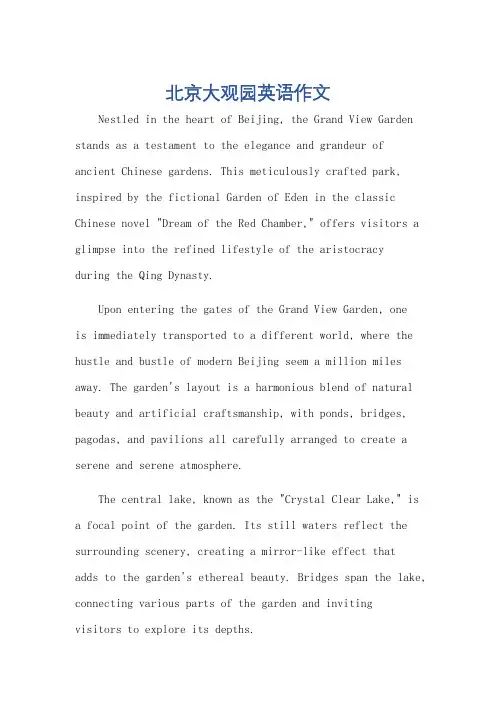
北京大观园英语作文Nestled in the heart of Beijing, the Grand View Garden stands as a testament to the elegance and grandeur of ancient Chinese gardens. This meticulously crafted park, inspired by the fictional Garden of Eden in the classic Chinese novel "Dream of the Red Chamber," offers visitors a glimpse into the refined lifestyle of the aristocracyduring the Qing Dynasty.Upon entering the gates of the Grand View Garden, oneis immediately transported to a different world, where the hustle and bustle of modern Beijing seem a million miles away. The garden's layout is a harmonious blend of natural beauty and artificial craftsmanship, with ponds, bridges, pagodas, and pavilions all carefully arranged to create a serene and serene atmosphere.The central lake, known as the "Crystal Clear Lake," is a focal point of the garden. Its still waters reflect the surrounding scenery, creating a mirror-like effect thatadds to the garden's ethereal beauty. Bridges span the lake, connecting various parts of the garden and invitingvisitors to explore its depths.One of the most striking features of the Grand View Garden is its extensive collection of trees and plants. From willows gracefully bending over the lake to flowering shrubs and bushes, every inch of the garden is alive with color and texture. The changing seasons bring new life to the garden, with spring blossoms, summer greenery, autumn foliage, and winter snowfalls all enhancing its natural beauty.In addition to its natural beauty, the Grand View Garden also preserves a rich cultural heritage. The park is filled with historical buildings and structures thatreflect the architectural styles of the Qing Dynasty. These include elegant pavilions, ornate temples, and intricate stone carvings, all of which provide a window into the past and the lives of the nobility.Visitors to the Grand View Garden can also participate in various cultural activities, such as tea ceremonies, calligraphy workshops, and traditional music performances. These activities provide a unique opportunity to immerse oneself in Chinese culture and experience it in a truly authentic setting.Overall, the Grand View Garden is a must-visit destination for anyone interested in Chinese culture and history. Its beauty, tranquility, and rich cultural heritage make it a truly memorable experience that will stay with visitors long after they leave the park.**北京大观园英语作文**坐落在北京心脏地带的北京大观园,是一座见证中国古代园林优雅与壮丽的杰作。
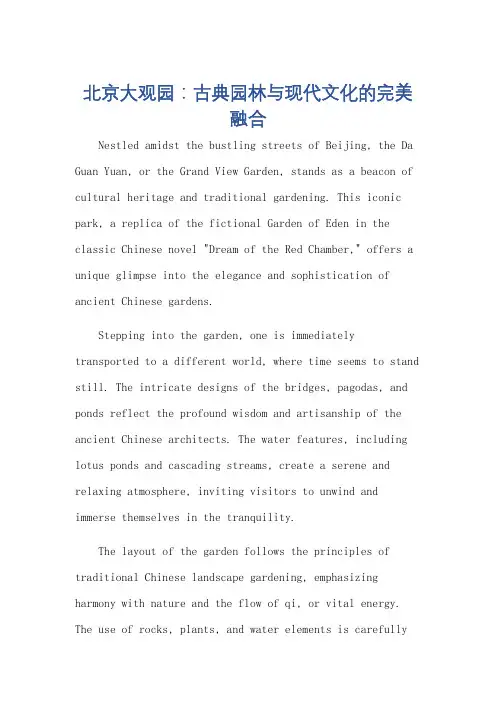
北京大观园:古典园林与现代文化的完美融合Nestled amidst the bustling streets of Beijing, the Da Guan Yuan, or the Grand View Garden, stands as a beacon of cultural heritage and traditional gardening. This iconic park, a replica of the fictional Garden of Eden in the classic Chinese novel "Dream of the Red Chamber," offers a unique glimpse into the elegance and sophistication of ancient Chinese gardens.Stepping into the garden, one is immediately transported to a different world, where time seems to stand still. The intricate designs of the bridges, pagodas, and ponds reflect the profound wisdom and artisanship of the ancient Chinese architects. The water features, including lotus ponds and cascading streams, create a serene and relaxing atmosphere, inviting visitors to unwind and immerse themselves in the tranquility.The layout of the garden follows the principles of traditional Chinese landscape gardening, emphasizing harmony with nature and the flow of qi, or vital energy. The use of rocks, plants, and water elements is carefullycrafted to create a balanced and harmonious environmentthat reflects the harmony sought in ancient Chinese philosophy.Not only does the Da Guan Yuan exhibit the beauty of ancient gardening, but it also serves as a vibrant cultural hub. Regular cultural events, such as traditional music performances, calligraphy exhibitions, and poetry readings, take place in the garden, allowing visitors to experience the rich cultural heritage of China. These activities not only enhance the visitor's understanding of Chinese culture but also promote cultural exchange and understanding between people from different backgrounds.Moreover, the garden is a popular filming location for historical dramas and movies, further highlighting its significance in preserving and promoting Chinese cultural heritage. Its authentic and well-preserved ancient architecture and landscapes provide a perfect backdrop for these productions, bringing the stories of the past to life on the silver screen.In conclusion, the Da Guan Yuan is not just a garden;it is a living museum of Chinese culture and history. Itcombines the elegance of ancient gardening with thevibrancy of modern cultural activities, offering a unique and immersive experience for visitors from all over the world. Whether you are interested in Chinese history, culture, or simply want to escape the hustle and bustle of the city, the Da Guan Yuan is a must-visit destination in Beijing.**北京大观园:古典园林与现代文化的完美融合**坐落于北京繁华街道之中的大观园,如同一座文化遗产与传统园林艺术的灯塔。
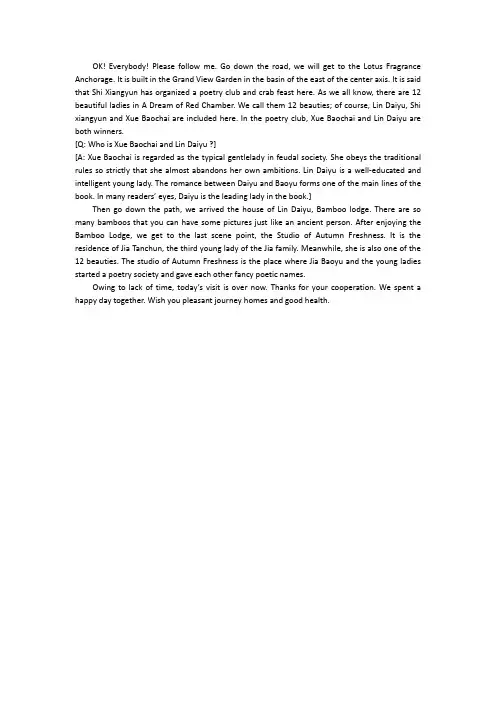
OK! Everybody! Please follow me. Go down the road, we will get to the Lotus Fragrance Anchorage. It is built in the Grand View Garden in the basin of the east of the center axis. It is said that Shi Xiangyun has organized a poetry club and crab feast here. As we all know, there are 12 beautiful ladies in A Dream of Red Chamber. We call them 12 beauties; of course, Lin Daiyu, Shi xiangyun and Xue Baochai are included here. In the poetry club, Xue Baochai and Lin Daiyu are both winners.[Q: Who is Xue Baochai and Lin Daiyu ?][A: Xue Baochai is regarded as the typical gentlelady in feudal society. She obeys the traditional rules so strictly that she almost abandons her own ambitions. Lin Daiyu is a well-educated and intelligent young lady. The romance between Daiyu and Baoyu forms one of the main lines of the book. In many readers’ eyes, Daiyu is the leading lady in the book.]Then go down the path, we arrived the house of Lin Daiyu, Bamboo lodge. There are so many bamboos that you can have some pictures just like an ancient person. After enjoying the Bamboo Lodge, we get to the last scene point, the Studio of Autumn Freshness. It is the residence of Jia Tanchun, the third young lady of the Jia family. Meanwhile, she is also one of the 12 beauties. The studio of Autumn Freshness is the place where Jia Baoyu and the young ladies started a poetry society and gave each other fancy poetic names.Owing to lack of time, today’s visit is over now. Thanks for your cooperation. We spent a happy day together. Wish you pleasant journey homes and good health.。
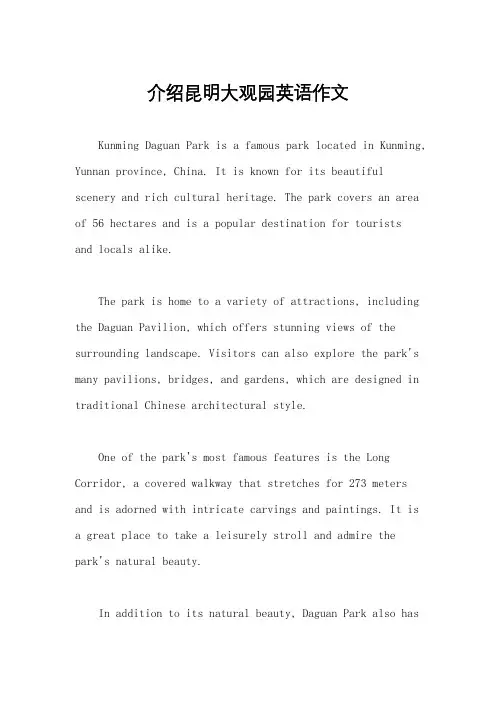
介绍昆明大观园英语作文Kunming Daguan Park is a famous park located in Kunming, Yunnan province, China. It is known for its beautiful scenery and rich cultural heritage. The park covers an area of 56 hectares and is a popular destination for touristsand locals alike.The park is home to a variety of attractions, including the Daguan Pavilion, which offers stunning views of the surrounding landscape. Visitors can also explore the park's many pavilions, bridges, and gardens, which are designed in traditional Chinese architectural style.One of the park's most famous features is the Long Corridor, a covered walkway that stretches for 273 meters and is adorned with intricate carvings and paintings. It is a great place to take a leisurely stroll and admire thepark's natural beauty.In addition to its natural beauty, Daguan Park also hasa rich cultural history. It was originally built during the Qing Dynasty and has been a popular retreat for poets, scholars, and emperors throughout history.Today, the park is a popular spot for locals to gather and enjoy outdoor activities such as tai chi, kite flying, and traditional Chinese music and dance performances. It is also a popular spot for couples to take wedding photos and for families to have picnics and enjoy the peaceful surroundings.Overall, Kunming Daguan Park is a must-visitdestination for anyone traveling to Kunming. Its combination of natural beauty, cultural significance, and recreational activities make it a truly unique and special place to explore.。
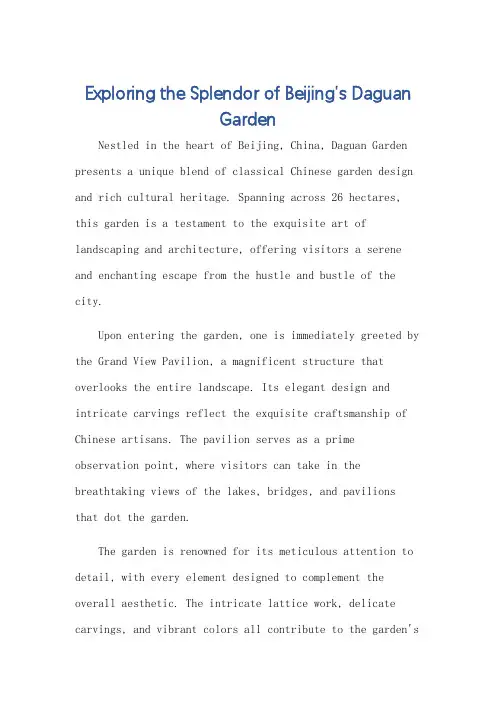
Exploring the Splendor of Beijing's DaguanGardenNestled in the heart of Beijing, China, Daguan Garden presents a unique blend of classical Chinese garden design and rich cultural heritage. Spanning across 26 hectares, this garden is a testament to the exquisite art of landscaping and architecture, offering visitors a serene and enchanting escape from the hustle and bustle of the city.Upon entering the garden, one is immediately greeted by the Grand View Pavilion, a magnificent structure that overlooks the entire landscape. Its elegant design and intricate carvings reflect the exquisite craftsmanship of Chinese artisans. The pavilion serves as a prime observation point, where visitors can take in the breathtaking views of the lakes, bridges, and pavilionsthat dot the garden.The garden is renowned for its meticulous attention to detail, with every element designed to complement the overall aesthetic. The intricate lattice work, delicate carvings, and vibrant colors all contribute to the garden'senchanting atmosphere. The water features, in particular, are a highlight, with their calm surfaces reflecting the surrounding foliage and structures.One of the garden's most noteworthy attractions is the Rockery, a masterful display of rock landscaping. The rockery features a collection of carefully selected rocks, some weighing tons, arranged in a way that mimics natural landscapes. This artistic composition, coupled with the strategic placement of plants and water features, creates a harmonious and calming environment.Daguan Garden is also home to various cultural exhibitions and performances, allowing visitors to delve deeper into the rich history and traditions of China. From traditional Chinese painting and calligraphy exhibitions to folk dance performances, these cultural events offer a window into the vibrant cultural life of the country.Moreover, the garden serves as a popular venue for weddings and other special occasions, providing a romantic and elegant backdrop for these celebrations. The scenic locations and historical significance of the garden make it a highly sought-after destination for these special events.In conclusion, Beijing's Daguan Garden is a must-visit destination for anyone interested in Chinese culture and园林艺术. Its meticulous design, cultural significance, and enchanting atmosphere make it a unique and memorable experience. Whether you are seeking a peaceful getawaywithin the city or want to delve into the rich history and traditions of China, Daguan Garden offers something for everyone.**探寻北京大观园的瑰丽**位于北京心脏地带的大观园,是一座融合了古典中国园林设计与丰富文化遗产的独特景观。

大观园英语导游词DaguanParkDaguan, which means ’the grand view’, is the most befitting name for the park and the pavilion which are on the terminus of Daguan Road in the southwest of Kunming city, Daguan Park and Daguan Pavilion.Daguan Park locates on the shore of Dianchi Lake and faces the Western Hills which are on the other side of Dianchi Lake. In 1682, a monk named Qianyin built a small temple here to give Buddhist lessons; eight years later, in 1690, the satrap of Yunnan Province Wang Jiwen was attracted by the beautiful natural views here and began to construct a whole park including many halls, pavilions, bonsais, rockeries, trees and porches. Daguan Park became an attraction from then on and the most famous spot among them is the Daguan Pavilion.Like many other Chinese ancient buildings, Daguan Pavilion also had been in disarray, destroyed and restored several times because of the dynastic changes and the civil wars. The present-day square, three-storied pavilion was established in 1883. At the entrance there is the longest antithetical couplet which was written by a famous Qing Dynasty scholar named Sun Ranweng (also called Sun Ran); this couplet of 180 characters is one of the most valued cultural treasures in Yunnan Province. The first part of the couplet describes the beautiful and magnificent natural views before your sight, tell people to enjoy and treasure. The second part reviews the 2000 years’ history of Yunnan,awakens to that no matter how successful or frustrated you are, all will be in nothingness in the end.Other sceneries like Santan Yingyue, Louwailou and Lu Garden, also beautiful places, deserve a visit. Santan Yingyue is a pool with three stone towers which divides the pool into three parts. Therefore when there is a moon in the sky there are three moons in the water; Louwailou is a stone pavilion built like a ship. Standing on it you can see Santan Yingyue on the right and the ocean of grass on the left, Dianchi Lake in front and levee behind; in the south of Daguan Park is the Lu Garden which was a private villa in 1937, with water lilies, roses, weeping willows and oleanders everywhere. Lu Garden looks like a little peaceful fairyland which is hiding in the corner of Daguan Park.True to its name, Daguan Park and the attractions in it provide spectacular and grand views in different styles. From the sparkling Dianchi Lake to the superb Western Hills, the natural beauties create a perfect place to spend your holiday. 来。
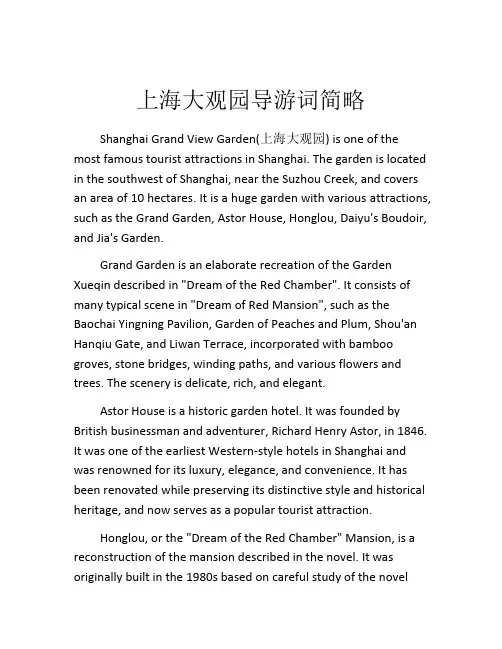
上海大观园导游词简略Shanghai Grand View Garden(上海大观园) is one of the most famous tourist attractions in Shanghai. The garden is located in the southwest of Shanghai, near the Suzhou Creek, and covers an area of 10 hectares. It is a huge garden with various attractions, such as the Grand Garden, Astor House, Honglou, Daiyu's Boudoir, and Jia's Garden.Grand Garden is an elaborate recreation of the Garden Xueqin described in "Dream of the Red Chamber". It consists of many typical scene in "Dream of Red Mansion", such as the Baochai Yingning Pavilion, Garden of Peaches and Plum, Shou'an Hanqiu Gate, and Liwan Terrace, incorporated with bamboo groves, stone bridges, winding paths, and various flowers and trees. The scenery is delicate, rich, and elegant.Astor House is a historic garden hotel. It was founded by British businessman and adventurer, Richard Henry Astor, in 1846. It was one of the earliest Western-style hotels in Shanghai and was renowned for its luxury, elegance, and convenience. It has been renovated while preserving its distinctive style and historical heritage, and now serves as a popular tourist attraction.Honglou, or the "Dream of the Red Chamber" Mansion, is a reconstruction of the mansion described in the novel. It was originally built in the 1980s based on careful study of the noveland has since undergone several renovations. It reflects the luxurious and sophisticated lifestyle of an ancient Chinese family, and it is a perfect place to get an idea of what Chinese and the upper class life looked like in the past.Daiyu's Boudoir is another part of the Shanghai Grand View Garden that visitors should not miss. It is the place where the heroine, Lin Daiyu, took up residence in the novel. The Boudoir was designed to be very romantic, featuring jade beds, mirror on the wall, and other Chinese traditional decorations. It is a good place to learn about the culture and the lifestyle of ancient Chinese women.Jia's Garden is the scenic spot where Jia family lived in the novel. It recreates the sophisticated and elegant lifestyle described in the novel. Visitors can take a leisurely stroll through the garden, explore the various corridors and pavilions, and admire the diverse flora and fauna.In conclusion, Shanghai Grand View Garden is a must-visit tourist attraction in Shanghai. It showcases the city's rich history and culture, offers a unique insight into the lives of ancient Chinese families and is a perfect place to relax and enjoy nature. Whether you are interested in history or just want to enjoy the beauty of the garden, Shanghai Grand View Garden is definitely worth a visit.。
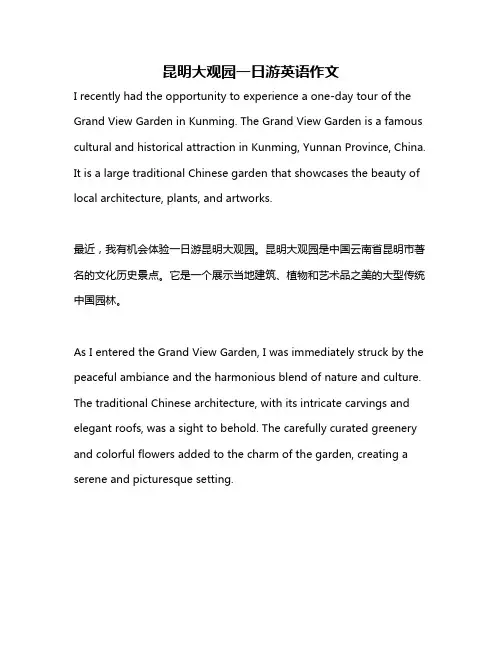
昆明大观园一日游英语作文I recently had the opportunity to experience a one-day tour of the Grand View Garden in Kunming. The Grand View Garden is a famous cultural and historical attraction in Kunming, Yunnan Province, China. It is a large traditional Chinese garden that showcases the beauty of local architecture, plants, and artworks.最近,我有机会体验一日游昆明大观园。
昆明大观园是中国云南省昆明市著名的文化历史景点。
它是一个展示当地建筑、植物和艺术品之美的大型传统中国园林。
As I entered the Grand View Garden, I was immediately struck by the peaceful ambiance and the harmonious blend of nature and culture. The traditional Chinese architecture, with its intricate carvings and elegant roofs, was a sight to behold. The carefully curated greenery and colorful flowers added to the charm of the garden, creating a serene and picturesque setting.当我进入大观园时,我立刻被宁静的氛围和自然与文化的和谐融合所吸引。
传统的中国建筑,其复杂的雕刻和优雅的屋顶,是令人叹为观止的景象。
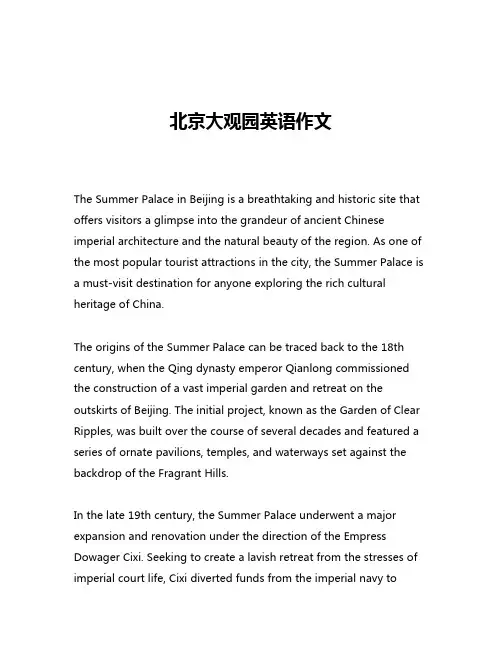
北京大观园英语作文The Summer Palace in Beijing is a breathtaking and historic site that offers visitors a glimpse into the grandeur of ancient Chinese imperial architecture and the natural beauty of the region. As one of the most popular tourist attractions in the city, the Summer Palace is a must-visit destination for anyone exploring the rich cultural heritage of China.The origins of the Summer Palace can be traced back to the 18th century, when the Qing dynasty emperor Qianlong commissioned the construction of a vast imperial garden and retreat on the outskirts of Beijing. The initial project, known as the Garden of Clear Ripples, was built over the course of several decades and featured a series of ornate pavilions, temples, and waterways set against the backdrop of the Fragrant Hills.In the late 19th century, the Summer Palace underwent a major expansion and renovation under the direction of the Empress Dowager Cixi. Seeking to create a lavish retreat from the stresses of imperial court life, Cixi diverted funds from the imperial navy tofinance the construction of a grand new complex, which included the iconic Marble Boat and the towering Long Corridor.Today, the Summer Palace covers an area of nearly 2.9 square kilometers, making it one of the largest and most impressive imperial gardens in the world. Visitors to the site can explore a diverse array of architectural styles, from the intricate carvings and vibrant frescoes of the Marble Boat to the serene beauty of the Kunming Lake and its surrounding islands.One of the most striking features of the Summer Palace is the Long Corridor, a covered walkway that stretches for nearly 700 meters along the northern shore of Kunming Lake. Adorned with more than 14,000 individual paintings depicting scenes from Chinese history, literature, and mythology, the Long Corridor is a true masterpiece of artistic expression and a testament to the skilled craftsmanship of the Qing dynasty artisans.Another iconic landmark within the Summer Palace is the Marble Boat, a fanciful structure that was originally constructed during the reign of Emperor Qianlong. The boat, which is made entirely of white marble, was designed to serve as a symbolic representation of the power and wealth of the Qing dynasty, and it remains one of the most photographed and iconic features of the entire complex.In addition to its architectural wonders, the Summer Palace is also renowned for its stunning natural scenery. The gardens are home to a diverse array of plant life, including towering trees, fragrant flowers, and tranquil ponds teeming with fish and waterfowl. Visitors can take a leisurely stroll through the gardens, admiring the breathtaking vistas and soaking in the peaceful ambiance of the site.One of the most popular activities at the Summer Palace is a boat ride on Kunming Lake. Visitors can board traditional Chinese-style boats and glide across the serene waters, taking in the stunning views of the surrounding hills and the ornate buildings that line the shoreline. This experience offers a unique perspective on the grandeur and beauty of the Summer Palace, and it is a must-do for anyone visiting the site.Despite the many challenges and adversities it has faced over the centuries, the Summer Palace has endured as a symbol of China's rich cultural heritage and the enduring power of its imperial legacy. From the intricate architectural details to the breathtaking natural landscapes, the Summer Palace is a true masterpiece that continues to captivate and inspire visitors from around the world.As one of the most iconic and well-preserved imperial gardens in China, the Summer Palace is a testament to the ingenuity and creativity of the Qing dynasty architects and artisans who brought itto life. Whether you are a history buff, an art enthusiast, or simply someone who appreciates the beauty of the natural world, a visit to the Summer Palace is sure to leave a lasting impression and provide a deeper understanding of the rich cultural heritage of China.。
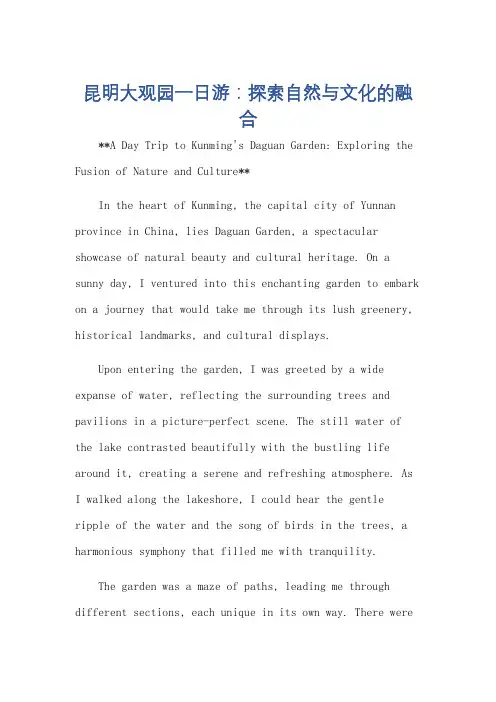
昆明大观园一日游:探索自然与文化的融合**A Day Trip to Kunming's Daguan Garden: Exploring the Fusion of Nature and Culture**In the heart of Kunming, the capital city of Yunnan province in China, lies Daguan Garden, a spectacular showcase of natural beauty and cultural heritage. On a sunny day, I ventured into this enchanting garden to embark on a journey that would take me through its lush greenery, historical landmarks, and cultural displays.Upon entering the garden, I was greeted by a wide expanse of water, reflecting the surrounding trees and pavilions in a picture-perfect scene. The still water of the lake contrasted beautifully with the bustling life around it, creating a serene and refreshing atmosphere. As I walked along the lakeshore, I could hear the gentleripple of the water and the song of birds in the trees, a harmonious symphony that filled me with tranquility.The garden was a maze of paths, leading me through different sections, each unique in its own way. There wereareas dedicated to flowers and plants, where I could smell the sweet fragrance of blooming flowers and admire their vibrant colors. In other parts, I found myself surrounded by towering trees, their branches intertwining overhead to form a canopy of green. These sections were like oases of peace, where I could lose myself in the serenity and forget the hustle and bustle of the city.As I explored further, I came across historical landmarks that told the story of Kunming and its rich cultural heritage. There were pavilions and temples dedicated to various deities and heroes, each with its own unique architecture and装饰. These structures were notjust historical relics; they were also active temples where locals came to pray and offer incense. The sight of people gathered in prayer added a sense of liveliness and spirituality to the garden.What made Daguan Garden truly special was its perfect blend of nature and culture. It was not just a place to欣赏美景; it was also a place to learn about the history and culture of Kunming. The garden was a testament to the harmony that could be achieved between man and nature,where human-made structures were seamlessly integrated into the natural landscape, rather than standing out asintrusive elements.My day trip to Daguan Garden was an unforgettable experience. It was not just a visit to a scenic spot; itwas a journey through time, where I could see the past and present coalesce into a beautiful tapestry of naturalbeauty and cultural richness. As I bid farewell to the garden, I knew that I would carry with me the memories ofits beauty and the lessons of its history, forever etchedin my heart.**昆明大观园一日游:探索自然与文化的融合**在云南省会昆明市中心,坐落着一座名为大观园的景区,它以其自然美景和文化遗产的完美结合而著称。
英语大观园之旅Stepping into the enchanting realm of the English Horticultural Garden, I am transported to a world of linguistic wonders and cultural riches. This garden, a vibrant mosaic of words and ideas, offers a unique opportunity to immerse oneself in the beauty and depth of the English language.The garden's entrance is marked by a stately archway, adorned with quotes from famous English writers. As I walk through, I am greeted by the sights and sounds of a vibrant linguistic ecosystem. The paths are lined with statues of literary giants, their faces etched with expressions of deep thought and inspiration.Amidst the lush greenery, I stumble upon a grove dedicated to the art of poetry. Here, the branches of the trees are adorned with poems, each one a unique expression of human emotion and experience. I pause to read a few, allowing their rhythmic cadences to wash over me like a gentle breeze.The garden also boasts a lively section devoted to the study of grammar and syntax. Here, intricate sculptures illustrate the intricate workings of the English language, from the basic building blocks of sentences to the complex interplay of clauses and phrases. I find myself lost in the maze of linguistic structures, fascinated by the precision and elegance of the English grammar.A stroll through the garden reveals yet another fascinating aspect - the diversity of English literature. From classic novels to contemporary works, the garden showcases the rich tapestry of English literary history. I pause to admire a fountain inspired by a famous novel, its waters spilling over in a dance of literary inspiration.But the English Horticultural Garden is not just about books and words. It is a celebration of the English language in all its forms and expressions. A nearbypavilion hosts regular events such as poetry readings, writing workshops, and even theatrical performances. These activities bring the garden to life, making it a vibrant hub of cultural exchange and learning.As the sun begins to set, I find myself reluctant to leave this magical place. The English Horticultural Garden has not only expanded my understanding of the English language but has also inspired me to delve deeper into its rich cultural heritage. It is a reminder that language is not just a tool for communication but a powerful medium for expressing our thoughts, feelings, and experiences.In conclusion, the English Horticultural Garden is a testament to the beauty and versatility of the English language. It is a place where words come alive, where literature blossoms, and where the joy of learning and exploring is ever present. It has left me with a renewed appreciation for the wonders of the English language and a desire to continue my journey of discovery in thislinguistic wonderland.**英语大观园之旅**走进英语大观园,我仿佛踏入了一个充满语言奇迹和文化宝藏的神奇世界。
上海大观园英文景点介绍Shanghai Grand View Garden IntroductionShanghai Grand View Garden, also known as Shanghai Daguanyuan, is a famous scenic spot in Shanghai, China. It is a large-scale garden that recreates scenes from the classic Chinese novel "Dream of the Red Chamber". The garden aims to bring to life the wealth, beauty, and elegance depicted in the original novel.Covering an area of 200,000 square meters, Shanghai Grand View Garden is divided into six main areas: Daguanyuan Area, Qinlin Villa Area, Ning Mansion Area, Rongguo Mansion Area, Xue Baochai Memorial Hall, and Jia Baoyu Memorial Hall. Each area is meticulously designed to resemble the locations mentioned in the book.Daguanyuan Area is the largest and most important section of the garden. It includes the Grand View Tower, which is the tallest building in the whole garden. From the top of the tower, visitors can enjoy a panoramic view of the entire garden and its picturesque surroundings.Qinlin Villa Area showcases the luxurious living quarters of the imperial family, with exquisite architecture and intricate decorations. Ning Mansion Area represents the homes of wealthy merchants and showcases their opulent lifestyle and grandeur. Rongguo Mansion Area, on the other hand, depicts the residences of high-ranking officials with its splendid architecture and grand courtyards.The Xue Baochai Memorial Hall is a highlight of the garden, dedicated to one of the novel's main characters, Xue Baochai. The hall displays various cultural relics and artworks related to Xue Baochai and the time period of the story. Similarly, the Jia Baoyu Memorial Hall honors the protagonist of the novel, Jia Baoyu, and showcases his life and story through exhibits and displays. Visitors to Shanghai Grand View Garden can immerse themselves in the fictional world of "Dream of the Red Chamber" and experience the beauty and grandeur of ancient Chinese culture. The garden's meticulous recreation of the novel's scenes, combined with its stunning architecture and scenic landscapes, make it a popular attraction among both domestic and international tourists.。
英语作文写大观园The Grand View Garden, a place of grandeur and tranquility, is a sanctuary where nature's beauty is captured in every corner. Its lush gardens, adorned with blooming flowers and whispering willows, offer a serene escape from the bustling city.As one wanders through the winding paths, the fragrance of jasmine and the gentle rustle of bamboo leaves create a symphony of senses. The garden's design is a testament to the harmony between man and nature, with pavilions and bridges seamlessly integrated into the landscape.The central lake, reflecting the azure sky, is home to schools of colorful koi fish that dart playfully beneath the surface. Ducks glide gracefully, adding a touch of life to the water's mirror-like surface.In the heart of the garden stands a majestic pagoda, its tiers reaching towards the heavens. It serves as a vantage point, offering panoramic views of the sprawling estate and its surrounding splendor.The Grand View Garden is not just a place of visual delight; it is a haven for the soul. It is a place where one can find solace, inspiration, and a connection to the timeless beauty of the world.As the sun sets, casting a golden glow over the garden, the silhouettes of the trees and structures create a picturesque scene. The tranquility of the evening is only broken by the occasional chirping of birds returning to their nests.Visiting the Grand View Garden is an experience that transcends time. It is a journey into a world where the past and present merge, leaving one with a sense of awe and a deeper appreciation for the art of gardening.In conclusion, the Grand View Garden is a treasure trove of natural and architectural wonders. It is a place that invites visitors to step back in time and immerse themselves in the elegance and serenity of a bygone era.。
昆明大观公园英语介绍Kunming Daguang Park, also known as the Grand View Park, is a renowned tourist attraction located in the capital city of Yunnan province in China. With a history dating back over 300 years, this immense park covers an area of about 120 hectares and is recognized as one of the largest and most picturesque parks in Kunming.One of the highlights of Daguang Park is its natural beauty. The park is surrounded by lush greenery and offers breathtaking panoramic views of the nearby Dianchi Lake and the Western Hills, creating an idyllic atmosphere for visitors to relax and enjoy nature. The park also features numerous well-maintained gardens, beautiful flower beds, and colorful plants, providing a feast for the eyes in every season.In addition to its remarkable scenery, Daguang Park is rich in cultural and historical significance. The park was originally built as a private garden during the Qing dynasty and has since been expanded and transformed into a public park. Throughout the park, visitors can explore various historic sites and architectural structures that reflect the region's heritage, such as the exquisite grand gate, pavilions, bridges, and ancestral halls. Furthermore, Daguang Park offers a wide range of recreational activities for visitors of all ages. There are playgrounds, boating facilities, walking paths, and even a small amusement park, making it an ideal destination for families and friends. The park is also home to several teahouses, where visitors can savor traditional Chinese tea and enjoy a peaceful moment amidst the tranquilsurroundings.Overall, a visit to Kunming Daguang Park is not only an opportunity to appreciate stunning natural landscapes but also an opportunity to immerse oneself in the local history and culture. With its peaceful ambiance, well-preserved architecture, and diverse recreational options, Daguang Park guarantees an unforgettable experience for every visitor.。
介绍昆明大观园的作文英文英文:Kunming Daguan Park is one of the most famous parks in Kunming, Yunnan Province, China. It is located in the southwest of the city, covering an area of 168 hectares. The park was built in 1696 during the Qing Dynasty and is known for its beautiful scenery and rich cultural heritage.As soon as I entered the park, I was greeted by the sight of the Daguan Pavilion. The pavilion is the most famous landmark in the park and is known for its stunning views of the Dianchi Lake. It was built in 1696 and is considered to be one of the most beautiful pavilions in China.Walking further into the park, I was amazed by the beautiful gardens, lakes, and bridges. The park is home to many different types of flowers and plants, including lotus flowers, peonies, and camellias. The lakes in the park arealso home to many different species of fish and birds.One of my favorite things about the park was the traditional Chinese architecture. The park is home to many different buildings and pavilions, each with its own unique design and history. The architecture is a perfect example of the rich cultural heritage of China.Overall, I had a wonderful time visiting Kunming Daguan Park. The park is a perfect place to relax and enjoy the natural beauty of China, and I would highly recommend it to anyone visiting Kunming.中文:昆明大观园是中国云南省昆明市最著名的公园之一,位于城市的西南部,占地面积168公顷。
介绍昆明大观园的作文英文Kunming Daguan Park is a famous scenic spot in Kunming, Yunnan Province, China. It is located in the southwestern part of the city, covering an area of about 180,000 square meters. The park is known for its beautiful natural scenery, rich cultural heritage, and unique architectural style.Walking into the park, the first thing that catchesyour eye is the magnificent Daguan Pavilion. It is a three-story wooden structure built in 1690 during the Qing Dynasty. The pavilion is surrounded by a large lake, which reflects its image and creates a picturesque scene.Visitors can climb up to the top of the pavilion to enjoy the panoramic view of the park and the nearby Dianchi Lake.As you stroll through the park, you will come across many other attractions, such as the Nine-Dragon Screen, the Jade Belt Bridge, and the Lotus Pool. The Nine-DragonScreen is a colorful ceramic wall with nine dragons carved on it. The Jade Belt Bridge is a stone bridge that spansover a small stream, and the Lotus Pool is a tranquil pond filled with blooming lotus flowers.In addition to its natural beauty, Daguan Park is also a cultural treasure trove. The park is home to many historical relics, such as the Yunnan Provincial Museum, the Daguanlou Theater, and the Daguanlou Library. The museum houses a collection of over 50,000 cultural relics, including bronze wares, jade articles, and pottery. The theater is a traditional Chinese opera house, where visitors can enjoy performances of local operas and other cultural shows. The library is a well-preserved ancient building, which used to be a place for scholars to study and exchange ideas.Overall, Kunming Daguan Park is a must-visit destination for anyone who wants to experience the beauty and culture of Yunnan Province. With its stunning natural scenery, rich cultural heritage, and unique architectural style, the park is a true gem of China.。
英文导游词大观园DaguanPark
大观园,是《红楼梦》中贾府为元春省亲而修建的,元春题其园之总名曰大观园,正殿匾额云顾恩思义。
元宵省亲后,元春命宝玉和诸钗入园居住。
它不仅是红楼人物活动的艺术舞台,也是现实主义作家曹雪芹总结当时江南园林和帝王苑囿创作出来的园林艺术瑰宝,大观园的园林设计对后世的园林建造产生了深远的影响。
1984年,于北京西城区
南菜园护城河畔建造大观园作为87版电视剧拍摄基地。
摄制完成后,景区对外开放。
Daguan, which means the grand view, is the most befitting name for the park and the pavilion which are on the terminus of Daguan Road in the southwest of Kunming city, Daguan Park and Daguan Pavilion.
Daguan Park locates on the shore of Dianchi Lake and faces the Western Hills which are on the other side of Dianchi Lake. In 1682, a monk named Qianyin built a small temple here to give Buddhist lessons; eight years later, in 1690, the satrap of Yunnan Province Wang Jiwen was attracted by the beautiful natural views here and began to construct a whole park including many halls, pavilions, bonsais, rockeries, trees and porches. Daguan Park became an attraction from then on and the most famous spot among them is the Daguan Pavilion.
Like many other Chinese ancient buildings, Daguan Pavilion also had been in disarray, destroyed and restored several times because of the dynastic changes and the civil wars. The present-day square, three-storied pavilion was established in 1883. At the entrance there is the longest antithetical couplet which was written by a famous Qing Dynasty scholar named Sun Ranweng (also called Sun Ran); this couplet of 180 characters is one of the。